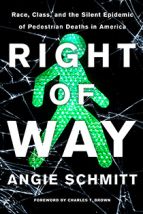Right of Way: Race, Class, and the Silent Epidemic of Pedestrian Deaths in America

On the one hand, there’s Tanzania. Though drivers make up a minority of urban residents, they tend to be the wealthiest and most powerful ones; thus infrastructural planning favours them. Author Angie Schmitt reports that “far more children are killed by cars, trucks, and motorcycles in urban Tanzania than are killed by AIDS, malaria, or diarrheal diseases” (page 146). Children sometimes carry out spontaneous protests – including sitting in the road – after motor vehicles hit their friends.
In sub-Saharan Africa cars are often associated with progress and prosperity, and international development interventions have at times made the problem worse. For instance, the Millennium Challenge Corporation funded the widening of Ghana’s National Highway 1 (renamed the George W. Bush Highway). The enlarged highway cut through poor residential neighbourhoods and forced their residents to dodge high-speed traffic as they walked to work or school. It became one of the most dangerous parts of Accra.
On the other hand, there’s Norway. Compared to Norway, road deaths are 11 times more common in Tanzania. Oslo had only one traffic death – of a driver – in 2019. In recent years it has also closed off much of its city centre to cars and converted parking spaces into recreational areas. In Europe more generally, pedestrian deaths declined by 36 per cent over the past decade.
Somewhere in between is the US. In the last decade, the fatality rates of drivers and passengers have increased by under 2 per cent. But for walkers and mobility device users, fatality rates are 50 per cent higher. The US is an outlier among wealthy countries for the scale of its road deaths and the laxness of its road laws. For instance, Schmitt refers to certain technologies, such as speed limiters and automatic emergency braking, as low-hanging fruit that demonstrably make driving safer. Yet authorities have been reluctant to mandate their inclusion or use in new cars. It does not help that SUVs are enormously popular in the US, as these cars are two to four times more likely to kill pedestrians after hitting them.
Yes, the US has sprawling cities, suburbs and open spaces. But neighbouring Canada, which is even less densely populated, has under half of the road deaths, adjusted for population. This is largely because of higher use of mass transit.
The US is also extremely resistant to basic regulations, for instance around lowering speed limits and implementing simple car-slowing mechanisms. Schmitt writes, “in most states, the laws are set up to protect drivers from speed traps, not to protect pedestrians from injuries” (page 164). Regulators are not just complacent; at times they’re downright obstructive. “Twenty- two US states have amended their constitutions to forbid any gasoline tax revenues at all from being spent on sidewalks. Many of these laws were passed in the 1960s with the financial backing of highway construction lobbyists” (page 14).
Right of Way will boil the blood of anyone who cares about pedestrian safety. It remains more convenient for many in car-centric cultures to blame individual pedestrians for their own injuries and deaths, rather than tackling the structural problems that make roads less safe.
Small-scale organizing has picked up some of the slack. In Mexico City, where cars account for only about 15 per cent of trips, a group led by Jorge Cáñez began painting sidewalks, crosswalks and bike lanes in 2011. Cáñez also began dressing as a luchador named Peatónito, doing eye-catching protests in his mask and cape. The visibility of the issue of road safety led to installation of some pedestrian infrastructure and the proliferation of pedestrian advocacy groups around Mexico.
Many countries have a strange tolerance of road deaths. But Right of Way stresses that these are preventable, not inevitable – for instance by redesigning commercial streets in the US. But across the world, one commonality is that pedestrian and cyclist deaths are more common among the poor, the elderly and the marginalized. Soberingly, according to Schmitt (page 5), “The lack of urgency around the problem may, in part, reflect the relatively low status of those being killed.”
Further reading:
Fazal, Shahab (2006), “Addressing congestion and transport-related air pollution in Saharanpur, India”, Environment and Urbanization Vol 18, No 1, pages 141–154, available at https://journals.sagepub.com/doi/abs/10.1177/0956247806063970.
Zipper, David (2020), “The life-saving car technology no one wants”, CityLab, 12 August, available at https://www.bloomberg.com/news/features/2020-08-12/why-are-cars-still-so....
Search the Book notes database
Our Book notes database contains details and summaries of all the publications included in Book notes since 1993 - with details on how to obtain/download.
Use the search form above, or visit the Book notes landing page for more options and latest content.
For a searchable database for papers in Environment and Urbanization, go to http://eau.sagepub.com/

